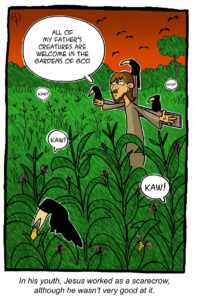 I am a perpetual student of the Bible. More specifically, of the New Testament. I am not an academic, nor have a pedigree that distinguishes me as an expert on anything Biblical, other than 50+ years of personal study of the New Testament scriptures via seminary, seminars, classes, conversations with actual scholars, and time with my nose in books by those supposedly in the know. I have even taken classes in New Testament Greek which I can read but have very little understanding.
I am a perpetual student of the Bible. More specifically, of the New Testament. I am not an academic, nor have a pedigree that distinguishes me as an expert on anything Biblical, other than 50+ years of personal study of the New Testament scriptures via seminary, seminars, classes, conversations with actual scholars, and time with my nose in books by those supposedly in the know. I have even taken classes in New Testament Greek which I can read but have very little understanding.
I have a passion for the person and history of Jesus of Nazareth. This last year I became reacquainted with an Aramaic Jesus scholar, Dr. Rocco Errico of the Noohra Foundation. He has devoted his life to the Aramaic history and story of Jesus as told from the Aramaic scriptures. It is Dr. Errico’s argument that the gospels were originally written down in Aramaic, and not Greek. The Greek was translated from the Aramaic, and like many translations of one language to another, lost the nuances of many of the cultural idioms and phrases unique to the Aramaic writings and the understanding of the Eastern language. One word can have more than one rightful meaning. Case in point would be Matthew 19:24, where in the Greek it reads, “it is easier for a camel to go thru the eye of a needle…” In Aramaic, the word for camel (gamala) is the same word for rope. Rope makes a lot more sense in the context of the verse.
Further examples of Greek vs. Aramaic translations:
Mark 14:18
(Greek) “…and when they drink deadly poison, it will not hurt them at all,”
(Aramaic) to be able to withstand any attacks against your character.
John 1:18
(Greek) referring to the “only begotten Son of God”
(Aramaic) The first one who recognizes the fatherhood of God. The only God-like man; hence, a spiritual Son of God.
John 1:14
(Greek) “…I saw thee under the fig tree.”
(Aramaic) I have known you always.
John 1:51
(Greek) “…you will see the heavens open and the angels of God ascending and descending on the son of Man.”
(Aramaic) An understanding between God and man; reconciliation.
Hence, the nuance of Aramaic over the Greek. Most New Testament scholars seem to wince at the idea of an Aramaic gospel tradition and argue for the original gospels as Greek writings. The debate over which translation is the original version lingers even today.
It is interesting to note that the Eastern Orthodox Church uses the Aramaic Peshitta (peshitta means single text or edition) translation and has done so since the inception of the Eastern Orthodox Church. They firmly believe that the Aramaic Peshitta text is the original writing of the Biblical gospels.
Dr. George Lamsa, mentor to Dr. Rocco Errico, produced one of the primary translations of the Aramaic Peshitta text Bible that is still recognized today as a primary source to those who support the Aramaic translation as original. Dr. Lamsa argues that the Aramaic Peshitta text was originally written sometime in the late first century and excluded the books of Revelation, 2nd Peter, 2nd and 3rd Epistle of John, and Jude. These excluded books were not canonical to the early Syriac church, that would indicate that there was a Syriac church in the late first century that used some form of an Aramaic gospel text.
Dr. Errico argues that Jesus was a peasant of Galilee, Nazareth specifically, meshed in the culture and life of this community. He grew up speaking Aramaic, as did his disciples. There is no actual evidence that Jesus even knew Greek or could speak it. He was literate in Aramaic because we know he hung out at the synagogue reading the scriptures. Dr. Errico further believes that Jesus grew up in the Nazarene culture taking care of the family farm, shepherding sheep, and harvesting crops. Dr. Errico maintains that Jesus’ father, Joseph, was not a carpenter in the traditional sense, but more of a maintenance man who fixed broken furniture. There is no evidence that Jesus was ever involved with that aspect of his father’s business. Jesus had a passion for the scriptures, and every chance he got would find him in the synagogue, reading and studying the scriptures and entering into conversation with the priests and scribes. Scripture does attest to Jesus by saying, “And Jesus increased in wisdom and stature, and in favor with God and man” (Luke 2:52).
It is evident that as a young man growing up in Nazareth, Jesus was deeply enmeshed in the culture of his heritage. If you recall, many of his stories and parables were about seeds, sheep, planting, and shepherding, which he knew firsthand.
I find Dr. Errico’s argument for an Aramaic Jesus very compelling and look forward to my journey into the Aramaic New Testament scriptures. As time and writing allows, hopefully I can share my findings in future blogs.




